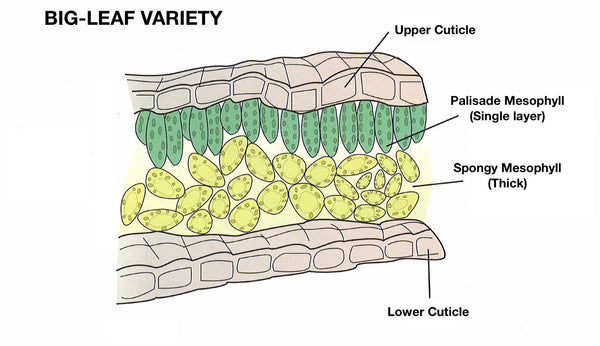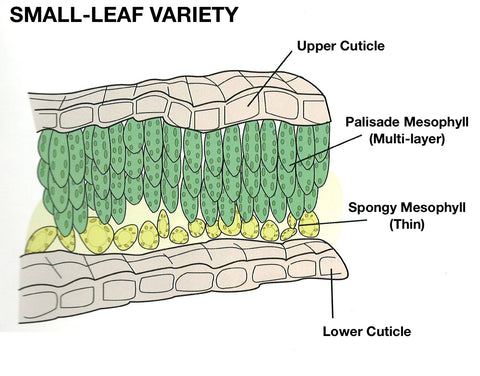BIG vs. SMALL-LEAF Tea Plant Varieties

Tea plants belong to the species Camelia Sinensis. Under this big umbrella, there are three varieties - Sinensis (often referred to as "small-leaf"), Cambodi ("medium-leaf"), and Assamica ("big-leaf"). Under these, there are numerous subvarieties (naturally occuring) and cultivars (produced with human intervention). These subvarieties and cultivars possess distinctive characteristics that dictate its flavor profile and the type of tea (e.g. black, green, oolong, etc.) they can suited to produce.
For the time being, let's start by learning more about the two main varieties - big-leaf vs. small-leaf.
As the names suggest, small-leaf and big-leaf varieties differ significantly in their leaf size. Generally speaking, the length of a big-leaf variety's leaf is > 10 cm (3.9 inches); that of a small-leaf variety is < 6 cm (2.4 inches).
Sinensis, the name of small-leaf variety, means "Chinese" in Latin. It is the variety most commonly found in China, Taiwan, and Japan. Small-leaf variety tea plants often grow as shrubs and are used to make green teas, oolong teas, and certain black teas. Their flavors tend to be more delicate and fragrant. Pu-erh tea from Yunnan, China is however a notable exception made with the big-leaf variety.
Assamica, the name of the big-leaf variety, refers (not surprisingly) to the region "Assam" in India where they were discovered in the 1800s by British colonists. They tend to grow as trees. Most of the black teas on the market today, in particular the CTC (Cut-Tear-Curl) tea leaves used in teabags, are made from the big-leaf variety. A notable exception would be Darjeeling teas, with origins from small-leaf variety tea plants brought over from China and transplanted in the mountains of Darjeeling.
In addition to size, big and small-leaf varieties differ significantly in their botanical structure and tea solids. Let's take a look at their leaf cross-sections below:

Due to its thin single-layer palisade mesophyll near the surface, big-leaf variety tea plants tends to get burnt easily and do not tolerate cold weather well. On the other hand, they have a thick multi-layer spongy mesophyll which contains abundant solids, in particular tea polyphenols (e.g. catechins) which contribute to bitterness and astringency. These solids undergo more processing during the production process (full oxidation vs. partial oxidation in oolong teas and no oxidation for green teas), in which the polyphenols are transformed into theaflavins, thearubigens, theabrowns, and other compounds that give black teas its bold, malty, and other complex flavors.

By comparison, the small-leaf variety tea plants have a thick multi-layer palisade mesophyll, protecting it better from the sun and cold weather. This thick layer also contain abundant chloroplasts and other solids that contribute to complex aromas. However, because of their thin spongy mesophyll layer, they contain less solids than the big-leaf variety and tend to taste milder and smoother by comparison.
As a general conclusion, big-leaf variety tea plants are found in regions closer to the equator. They are well-suited for heavy processing and making bold complex black teas. The small-leaf variety, found in regions further from the equator and at higher altitudes, require less processing and make more fragrant and delicate teas.
Note: Below is an alternative way of classifying big vs. small-leaf based on surface area. The surface area of a mature bud's first leaf (when fully grown) is measured.
- Small-Leaf variety: Surface area < 20 cm2
- Big-Leaf variety: Surface area > 40 cm2
- Surface area calculation: Length of leaf x Width of leaf x 70%